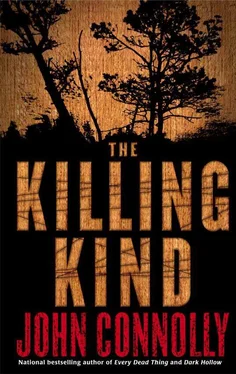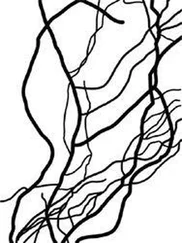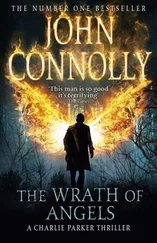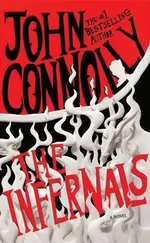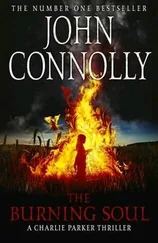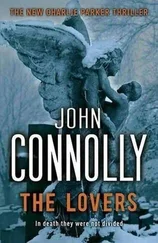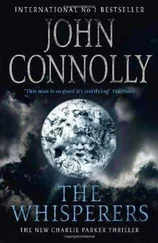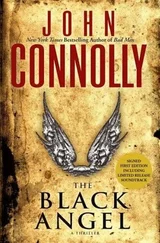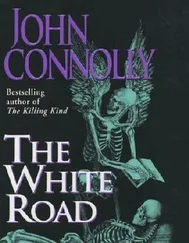But it was the illustrations that drew the eye. There were echoes of Dürer and Duvet in them, of Blake and Cranach and later artists too: Goerg and Meidner and Masereel. They were not copies of the original illustrations, but variations on a theme. Some were painted in ornate colors, while others used only carbon black mixed with iron gall to create a dense ink that stood out from the page. A version of Hell Mouth drawn from the Winchester Psalter marked the first page, hundreds of tiny bodies twisting in what looked like the jaws of a creature half man, half fish. A greenish tint had been added to the human figures so that they stood out from the skin on which they had been inscribed, and the scales of the fish were marked individually in shades of blue and red. Elsewhere, I found Cranach's Four Horsemen in red and black; Burgkmair's Harvest of the World in tones of green and gold; a vision of an arachnid beast, inspired by the twentieth-century artist Edouard Goerg, beside the words, “The beast that ascendeth out of the bottomless pit shall make war against them, and shall overcome them all, and kill them”; and a richly detailed variation on Duvet's frontispiece for his 1555 Apocalypse, depicting St. John against a backdrop of a great city, surrounded by emblems of death, including a swan with an arrow in its mouth.
I flicked forward to the last completed illustration, which accompanied a quotation from Revelation 10:10: “And I took the little book out of the angel's hand, and ate it up; and it was in my mouth sweet as honey: and as soon as I had eaten it, my belly was bitter.” Inspired by Dürer, the illustration depicted, once again, St. John, a sword in one hand as he consumed a representation of the very book I now held in my hand, the human spine and the spider with the key clearly visible as he fed it to himself. An angel watched him, its feet pillars of fire, its head like the sun.
St. John had been drawn in black ink and enormous effort had been expended in detailing the expression on his face. It was a representation of Faulkner as he was in his younger days, reminiscent of the picture of him that I had seen in the newspaper following the discovery of the bodies to the north. There was the same high brow, the same sunken cheeks and almost feminine mouth, the same straight, dark brows. He was swathed in a long white cloak, his left hand raising the sword toward the sky above.
Faulkner was in every illustration. He was one of the Four Horsemen; he was the jaws of hell; he was St. John; he was the beast. Faulkner: judging, tormenting, consuming, killing; creating a book that was both a record of punishment and a punishment in itself; an unveiling and a concealing of the truth; a vanity and a mockery of vanities; a work of art and an act of cannibalism. This was his life's work, begun when the human weaknesses of his followers displayed themselves and he turned against them, destroying them all with the aid of his brood: the men first, then the women, and finally the children. As he had begun, so he had continued, and the fallen had become part of his great book.
In the bottom right-hand corner of each page, like marginalia, were written names. The pages constructed of a single sheet of skin bore only one name, while those made up of a number of sections contained two, three, or sometimes four names. James Jessop's name was on the third fragment of skin, his mother's on the fourth, and his father's on the fifth. The rest of the Aroostook Baptists took up the majority of the book's entries, but there were other names too, names that I did not recognize, some of them comparatively recent, judging by the color of the ink on the skin. Alison Beck's name was not among them. Neither was Al Z's, or Epstein's, or Mickey Shine's. They would all have been added later, once the book had been retrieved, just as Grace Peltier's name would also have been written, and perhaps my own as well.
I thought back to Jack Mercier and the volume I had been shown in his study, its three double spine markings here transformed from gold to bone. A craftsman like Faulkner would not simply have ceased to make the books he loved so much. The copy presented to Carter Paragon was proof of that. Now it was clear that Faulkner had a wider vision: the creation of a text whose form perfectly mirrored its subject; a book about damnation made up of the bodies of the damned; a record of judgment composed of the remains of those who had been judged.
And Grace had found him. Deborah Mercier, jealous of her husband's first daughter, had told her of the existence of the new Apocalypse and its source. By then, Jack Mercier had already commenced his moves against the Fellowship, recruiting Ober, Beck, and Epstein to his cause, but Grace couldn't have known that, because it was more than Deborah Mercier would have been willing to tell her. She would put Grace at risk, but not her husband.
Grace had confronted Paragon with her knowledge of the sale of the Apocalypse, but Paragon was simply a dupe and Grace, clever woman, must have guessed it. He would have been afraid to tell Pudd and Faulkner that he had sold the book, but he would also have been too frightened to tell them nothing of Grace's visit. And so Grace had watched him and waited for him to panic. Did she follow him north, or wait for them to come to him? I suspected the latter if Paragon had died because he could not tell the Golem of their hiding place. Whatever had occurred, Grace had somehow found her way to the very gates of Faulkner's own, private hell. And then, when the opportunity arose, she made her way in and managed to escape with this book, a book that contained the truth about the fate of the Aroostook Baptists and, in particular, Elizabeth Jessop. Its theft had forced the Fellowship to respond quickly; while Pudd and the others searched for it, they set about eliminating all those who were moving against them and for whom the work stolen by Grace Peltier would have been a powerful weapon, a task that assumed a new urgency with the discovery of the bodies at St. Froid Lake.
I closed the volume, laid it carefully in its packaging, then ran my hands under the kitchen faucet. When I had cleaned them thoroughly I picked up a towel and turned to face Rachel and Louis.
“Looks like we got a whole new definition of the word ‘crazy,’ ” muttered Louis. “You know what that thing is supposed to be?”
“It's a record,” I replied. “A journal of deaths, and maybe more than that. It's an account of the damned, the opposite of the book of life. The Aroostook Baptists are in there, and at least a dozen other names, male and female, all used to create a new Apocalypse.
“And Faulkner made it. His remains weren't among those found at the grave site; neither were his son's or those of his daughter. They killed those people, all of them, then used parts of them to create his book. I think the other names are those of people who've had the misfortune to cross the Fellowship at some time, or who posed a threat and had to be eliminated. Eventually, parts of Grace and Curtis Peltier, Yossi Epstein, and maybe a piece of Jack Mercier and the others on the boat would have been added, once the book had been retrieved. It would have to be as complete a record as possible, otherwise it would have no meaning.”
“I take it you're using ‘meaning’ in the loosest possible sense,” said Rachel. Her disgust was obvious.
I was rubbing my hands red on the towel yet still feeling the taint of the book upon me. “Its meaning doesn't matter,” I said. “This thing is a confession to murder, once it can be traced back to Faulkner.”
“If we can find him,” added Louis. “What's going to happen when Lutz don't report back?”
“Then he'll send someone else, probably Pudd, to find out what happened. He can't let this book remain out in the world. That's assuming that our friend with the bald head doesn't get to him first.”
Читать дальше
